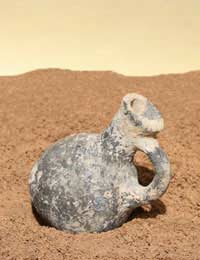
Archaeological Jargon
Archaeology like any scientific discipline has developed its own unique jargon words – a lexicon, if you like. In order to fully appreciate the measure of archaeological thought it is helpful to have definitions of some of those terms. Here is an introductory list of some of the common jargon and expressions likely to be heard on the archaeology digging site or in published journals, along with definitions of their meaning.
A.D.: The initials A.D. (when with year numbers) is an abbreviation for the Latin Anno Domini, which translated means the Year of Our Lord, referring to years after the birth of Jesus Christ.
Archaeology: Archaeology is defined as the science of discovering how societies in the past thought, felt and acted, organised their way of life and interacted with others and their environment, and in meeting their needs politically, economically and spiritually by re-discovering and interpreting the material remains of their civilisations.
Area: Area is jargon for the smallest contained digging space in the shape of a square usually about 5m x 5m. Archaeologists will often refer to their Area as a ‘square’.
Artefact: Any object made, modified, or used by humans.
B.C or B.C.E.: The initials B.C. stand for Before Christ. Some cultures and academics choose to use B.C.E. meaning Before the Common Era.
Baulk: A one metre unexcavated walkway between Areas.
C.E.: The initials C.E. (when with year numbers) is an abbreviation for Common Era and is jargon used to substitute the letters A.D. by cultures who do not accept Jesus Christ.
Cuneiform: A style of wedge-shaped writing common in the Middle East which pre-dated letters by 1500 years. Writing was scribed into soft clay using a specially shaped tool.
Descriptive Evidence: In archaeology terms, this is a written report about the contents of each excavated layer.
Feature: Feature is jargon for any material remains that cannot be removed from a site such as pits, house floors, fire hearths, or large stone altars.
Field: A group of adjoining excavation Areas.
Hieroglyphic: An ancient Egyptian system of writing, a full lexicon usually taught by the priests, using symbols and pictures to convey ideas and language.
Identification: Everything found at the archaeology site is given a special identification number. No two items have the same number. Each number corresponds to the Field, Area and item number. A letter followed by a number then a decimal point and three more numbers. e.g. Artefact No. B4.006 would be the sixth item found at Area 4 in Field B.
In Situ: In its original place.
Layers (locus): Layers is jargon for the sequence of different levels in the Area being excavated. They are sequentially numbered with the highest level being number one.
Midden: A rubbish heap or pit containing quantities of organic remains.
Potsherds: The definition of potsherds is broken pieces of ceramic or pottery artefacts including storage and cooking vessels, building material such as adobe brick and occasionally tools and furniture. They are common to nearly every digging site.
Shards: Shards are broken fragments of glass artefacts including perfume jars, jugs and serving or storage vessels. Very common throughout the Roman period.
Site: Site is archaeology jargon that is contained within the perimeter of all of the Fields at an archaeology excavation.
Spatial Evidence: Plans and pictures of the physical dimensions of each layer.
Stratigraphy: The archaeology definition of spatial evidence is the cultural remains and natural deposits form layers over time. Stratigraphic excavation is the digging out of an Area by completely clearing each strata layer before going any deeper.
Tel: A tel is a conglomerate of rocks, soils and ancient building materials which, over many years have formed a mound.
Translating: The process of rendering the sense of another language. Changing one language into another.